实验作业1
四、实验结论
实验任务1
代码1
1 // 现代C++标准库、算法库体验 2 // 本例用到以下内容: 3 // 1. 字符串string, 动态数组容器类vector、迭代器 4 // 2. 算法库:反转元素次序、旋转元素 5 // 3. 函数模板、const引用作为形参 6 #include <iostream> 7 #include <string> 8 #include <vector> 9 #include <algorithm> 10 // 模板函数声明 11 template<typename T> 12 void output(const T &c); 13 void test1(); 14 void test2(); 15 void test3(); 16 int main() { 17 std::cout << "测试1: \n"; 18 test1(); 19 std::cout << "\n测试2: \n"; 20 test2(); 21 std::cout << "\n测试3: \n"; 22 test3(); 23 } 24 // 输出容器对象c中的元素 25 template <typename T> 26 void output(const T &c) { 27 for(auto &i : c) 28 std::cout << i << ' '; 29 std::cout << '\n'; 30 } 31 // 测试1:组合使用算法库、迭代器、string反转字符串 32 void test1() { 33 using namespace std; 34 string s0{"0123456789"}; 35 cout << "s0 = " << s0 << endl; 36 string s1(s0); 37 // 反转s1自身 38 reverse(s1.begin(), s1.end()); 39 cout << "s1 = " << s1 << endl; 40 string s2(s0.size(), ' '); 41 // 将s0反转后结果拷贝到s2, s0自身不变 42 reverse_copy(s0.begin(), s0.end(), s2.begin()); 43 cout << "s2 = " << s2 << endl; 44 } 45 // 测试2:组合使用算法库、迭代器、vector反转动态数组对象vector内数据 46 void test2() { 47 using namespace std; 48 vector<int> v0{2, 0, 4, 9}; 49 cout << "v0: "; output(v0); 50 vector<int> v1{v0}; 51 reverse(v1.begin(), v1.end()); 52 cout << "v1: "; output(v1); 53 vector<int> v2{v0}; 54 reverse_copy(v0.begin(), v0.end(), v2.begin()); 55 cout << "v2: "; output(v2); 56 } 57 // 测试3:组合使用算法库、迭代器、vector实现元素旋转移位 58 void test3() { 59 using namespace std; 60 vector<int> v0{0, 1, 2, 3, 4, 5, 6, 7, 8, 9}; 61 cout << "v0: "; output(v0); 62 vector<int> v1{v0}; 63 // 将[v1.begin(), v1.end())区间内元素循环左移1位 64 rotate(v1.begin(), v1.begin()+1, v1.end()); 65 cout << "v1: "; output(v1); 66 vector<int> v2{v0}; 67 // 将[v1.begin(), v1.end())区间内元素循环左移2位 68 rotate(v2.begin(), v2.begin()+2, v2.end()); 69 cout << "v2: "; output(v2); 70 vector<int> v3{v0}; 71 // 将[v1.begin(), v1.end())区间内元素循环右移1位 72 rotate(v3.begin(), v3.end()-1, v3.end()); 73 cout << "v3: "; output(v3); 74 vector<int> v4{v0}; 75 // 将[v1.begin(), v1.end())区间内元素循环右移2位 76 rotate(v4.begin(), v4.end()-2, v4.end()); 77 cout << "v4: "; output(v4); 78 }
运行截图1
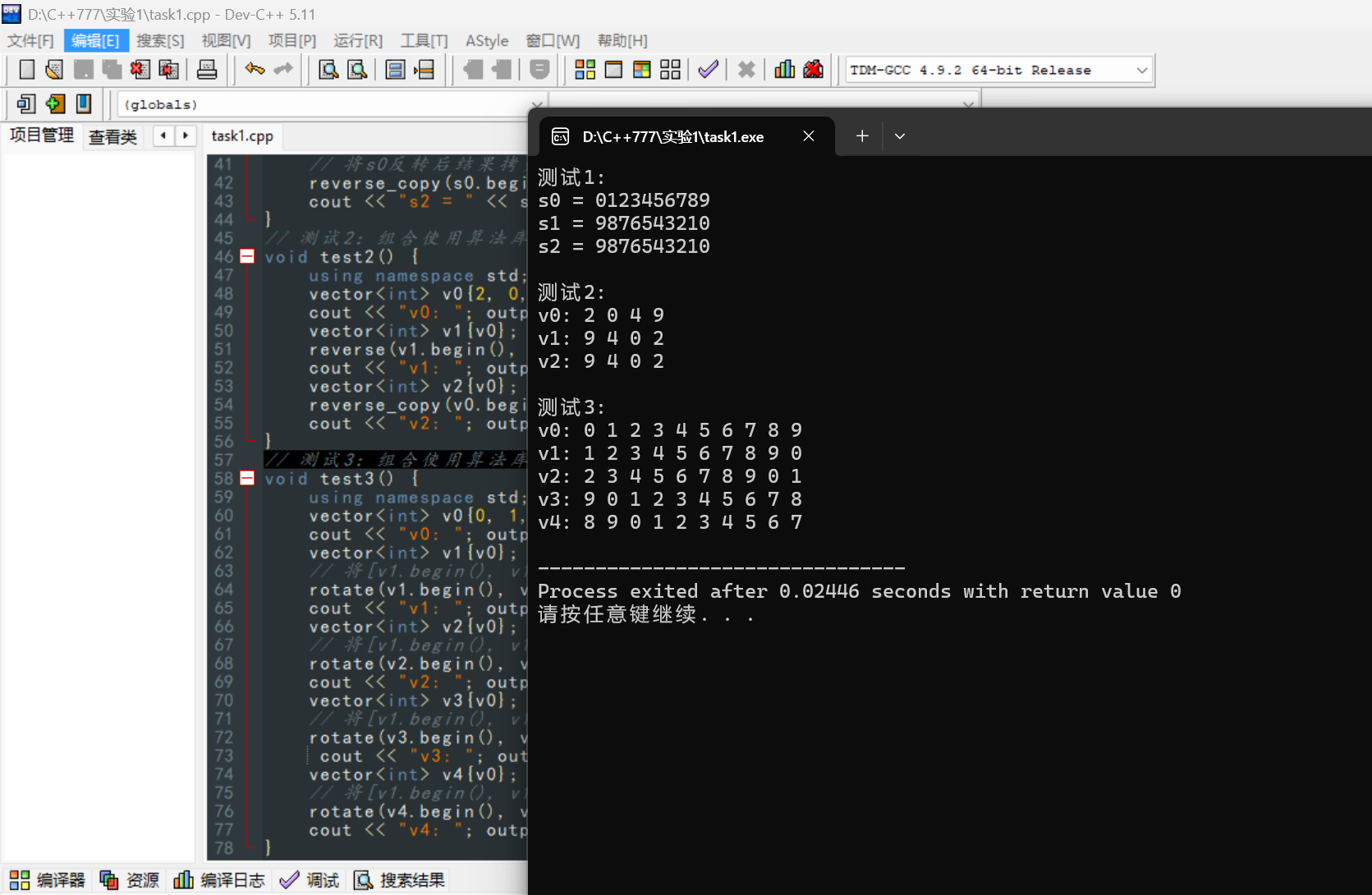
问题回答1-1
reverse 直接修改原容器,而 reverse_copy 生成反转后的副本,原容器不变,需要额外的输出迭代器。
问题回答1-2
rotate根据middle指针把区间[first,last)拆成两段[first,middle)和[middle,last),然后把后段移到前段前面,前段移动到后段后面,得到新的字符串。
first:待操作区间的起始迭代器,middle:新的起始点,last:代操作区间的结束位置+1。
实验任务2
代码2
#include <iostream> #include <vector> #include <algorithm> #include <numeric> #include <iomanip> #include <cstdlib> #include <ctime> // 模板函数声明 template<typename T> void output(const T &c); int generate_random_number(); void test1(); void test2(); int main() { std::srand(std::time(0)); // 添加随机种子 std::cout << "测试1: \n"; test1(); std::cout << "\n测试2: \n"; test2(); } // 输出容器对象c中的元素 template <typename T> void output(const T &c) { for(auto &i: c) std::cout << i << ' '; std::cout << '\n'; } // 返回[0, 100]区间内的一个随机整数 int generate_random_number() { return std::rand() % 101; } // 测试1:对容器类对象指定迭代器区间赋值、排序 void test1() { using namespace std; vector<int> v0(10);// 创建一个动态数组对象v0, 对象大小为10 generate(v0.begin(), v0.end(), generate_random_number); // 生成随机数填充v0 cout << "v0: "; output(v0); vector<int> v1{v0}; sort(v1.begin(), v1.end()); // 对整个vector排序 cout << "v1: "; output(v1); vector<int> v2{v0}; sort(v2.begin()+1, v2.end()-1); // 只对中间部分排序,不包含首尾元素 cout << "v2: "; output(v2); } // 测试2:对容器类对象指定迭代器区间赋值、计算最大值/最小值/均值 void test2() { using namespace std; vector<int> v0(10); generate(v0.begin(), v0.end(), generate_random_number); cout << "v0: "; output(v0); // 求最大值和最小值 auto min_iter = min_element(v0.begin(), v0.end()); auto max_iter = max_element(v0.begin(), v0.end()); cout << "最小值: " << *min_iter << endl; cout << "最大值: " << *max_iter << endl; // 同时求最大值和最小值 auto ans = minmax_element(v0.begin(), v0.end()); cout << "最小值: " << *(ans.first) << endl; cout << "最大值: " << *(ans.second) << endl; // 求平均值 double avg1 = accumulate(v0.begin(), v0.end(), 0.0) / v0.size(); cout << "均值: " << fixed << setprecision(2) << avg1 << endl; sort(v0.begin(), v0.end()); double avg2 = accumulate(v0.begin()+1, v0.end()-1, 0.0) / (v0.size()-2); cout << "去掉最大值、最小值之后,均值: " << avg2 << endl; }
运行截图2
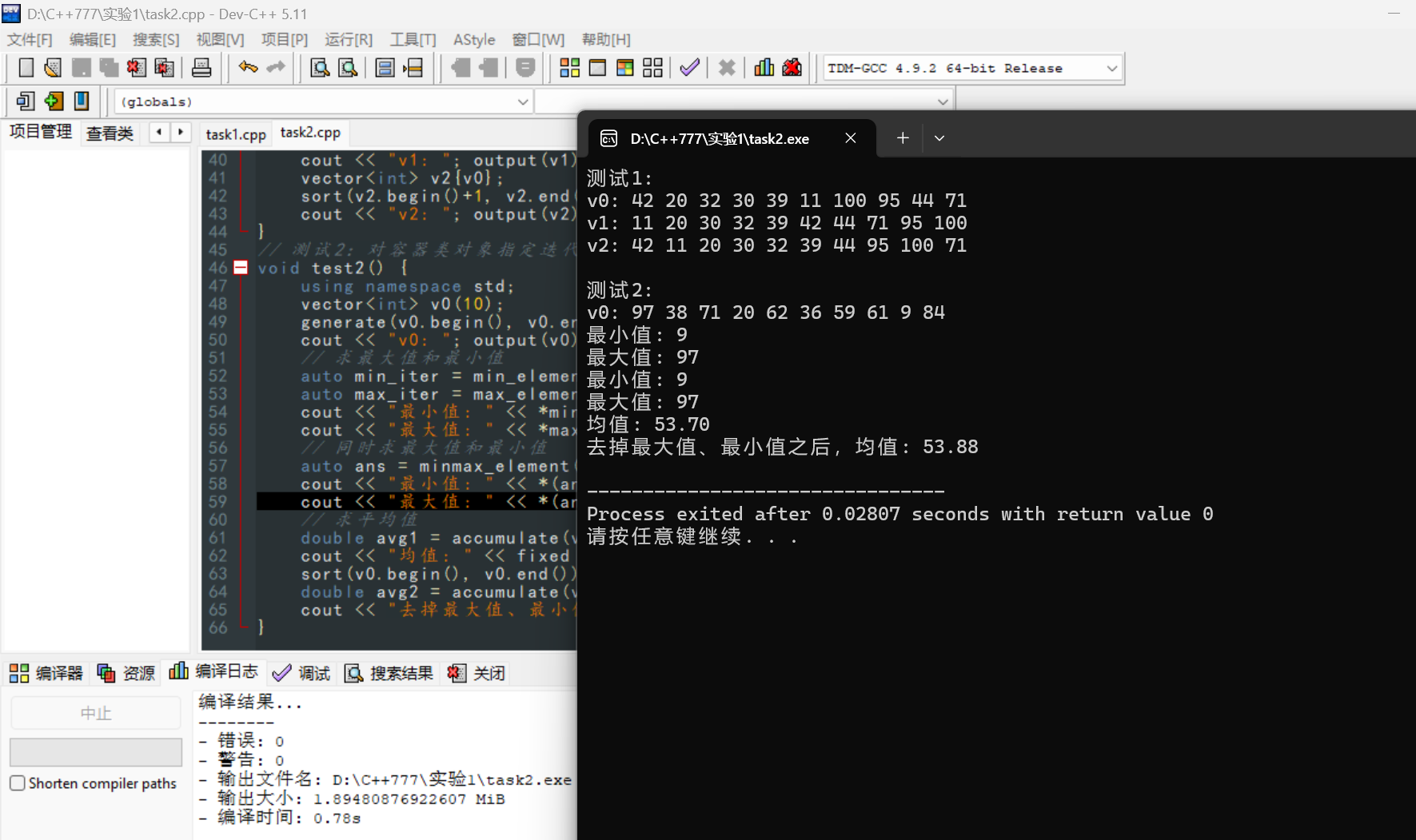
问题回答2-1
generate用于将区间[first,last)的元素,通过指定的函数生成的新值顺序赋值。
问题回答2-2
minmax_element只需要遍历一次区间,就可以同时找到最小值和最大值,而分别调用min_element和max_element需要对区间进行两次遍历;
使用前者只要写一遍逻辑,而使用后者需要写两次逻辑,所以前者也能使代码更简洁、清晰,而后者略显冗余。
问题回答2-3
相比于自定义函数,lambda的特点如下——无需单独定义一个函数,直接在调用处内嵌生成逻辑,所以更简洁;lambda表达式的作用范围只在调用的上下文中,不会有全局命名污染的问题。但也有些缺点,自定义函数有更好的代码复用性,而且当逻辑复杂时,自定义函数的可读性更高。所以lambda适用于生成器函数的逻辑较为简单且只在当前上下文使用,无需重复条用的情况,而自定义函数适用于生成器函数逻辑复杂,放在lambda表达式中会影响代码可读性的情况,以及该逻辑需要在多个地方使用时。其实有的时候为了方便单独测试也会把一个lambda表达式单独拎出来变成一个普通的函数。
实验任务3
代码3
#include <iostream> #include <string> #include <algorithm> #include <cctype> unsigned char func(unsigned char c); void test1(); void test2(); int main() { std::cout << "测试1: 字符串大小写转换\n"; test1(); std::cout << "\n测试2: 字符变换\n"; test2(); } unsigned char func(unsigned char c) { if(c == 'z') return 'a'; if(c == 'Z') return 'A'; if(std::isalpha(c)) return static_cast<unsigned char>(c+1); return c; } void test1() { std::string s1{"Hello World 2049!"}; std::cout << "s1 = " << s1 << '\n'; std::string s2; for(auto c: s1) s2 += std::tolower(c); std::cout << "s2 = " << s2 << '\n'; std::string s3; for(auto c: s1) s3 += std::toupper(c); std::cout << "s3 = " << s3 << '\n'; } void test2() { std::string s1{"I love cosmos!"}; std::cout << "s1 = " << s1 << '\n'; std::string s2(s1.size(), ' '); std::transform(s1.begin(), s1.end(), s2.begin(), func); std::cout << "s2 = " << s2 << '\n'; }
运行截图3

问题回答3-1
func的功能是传来的字母按照字母表顺序“循环递增”,但不改变大小写,且非字母保持不变。
问题回答3-2
tolower将字符转为小写字母,但非字母保持不变;toupper将字符转化为大写字母,但非字母保持不变。
问题回答3-3-1
第一个参数代表输入区间的起始迭代器;第二个参数代表输入区间的结束迭代器,且不包含该位置,第三个参数代表输出区间的起始迭代器,存储变换后的结果的起始位置;第四个参数即对每个输入元素执行的变换函数。
问题回答3-3-2
如果将s2.begin()改为s1.begin(),则输出结果会直接覆盖s1的内容,则s2中的内容不变,而s1中的内容被覆盖为转化后的情况。
实验任务4
代码4
#include <iostream> #include <string> #include <algorithm> bool is_palindrome(const std::string &s); bool is_palindrome_ignore_case(const std::string &s); int main() { using namespace std; string s; // 多组输入,直到按下Ctrl+Z结束测试 while(cin >> s) { cout << boolalpha << "区分大小写: " << is_palindrome(s) << "\n" << "不区分大小写: " << is_palindrome_ignore_case(s) << "\n\n"; } } // 函数is_palindrome定义 // 待补足 // ××× bool is_palindrome(const std::string &s) { auto left = s.begin(), right = s.end() - 1; while (left < right) { if (*left != *right) { return false; } ++left; --right; } return true; } // 函数is_palindrome_ignore_case定义 // 待补足 // ××× bool is_palindrome_ignore_case(const std::string &s) { auto left = s.begin(), right = s.end() - 1; while (left < right) { if (std::tolower(*left) != std::tolower(*right)) { return false; } ++left; --right; } return true; }
运行截图4
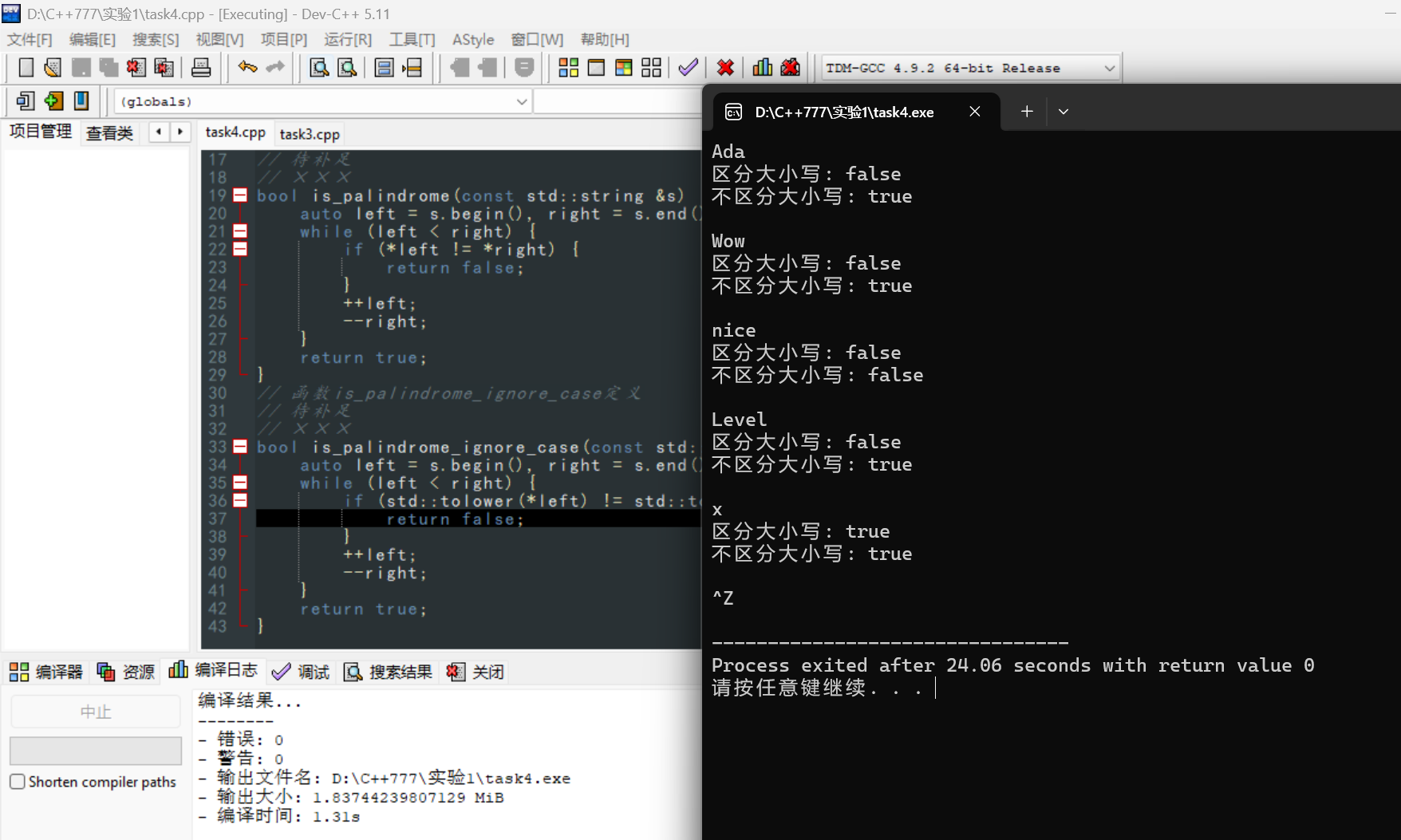
问题回答4
可以改用std::getline(cin, s),会读取整行的输入,包括空格,直到遇到换行符为止。
实验任务5
代码5
#include <iostream> #include <string> #include <algorithm> std::string dec2n(int x, int n = 2); int main() { int x; while(std::cin >> x) { std::cout << "十进制: " << x << '\n' << "二进制: " << dec2n(x) << '\n' << "八进制: " << dec2n(x, 8) << '\n' << "十二进制: " << dec2n(x, 12) << '\n' << "十六进制: " << dec2n(x, 16) << '\n' << "三十二进制: " << dec2n(x, 32) << "\n\n"; } } // 函数dec2n定义 // 待补足 // ××× inline char digit(int num) { return (num < 10)?(num + '0'):(num - 10 + 'A'); } std::string dec2n(int x, int n) { std::string answer; do { answer.push_back(digit(x % n)); x /= n; } while(x != 0); reverse(answer.begin(), answer.end()); return answer; }
运行截图5
![截图5]()
实验任务6
代码6
#include<iostream> #include <iomanip> int main() { using std::cout; using std::endl; using std::setw; using std::setfill; cout << " "; for (char i = 'a'; i <= 'z'; i++) { cout << " " << i; } char c = 'A'; for (int i = 1; i <= 26; i++) { cout << endl << setw(2) << setfill(' ') << i; c++; if (c > 'Z') c = 'A'; for (int j = 1; j <= 26; j++) { cout << " " << c++; if (c > 'Z') c = 'A'; } } }
运行截图6
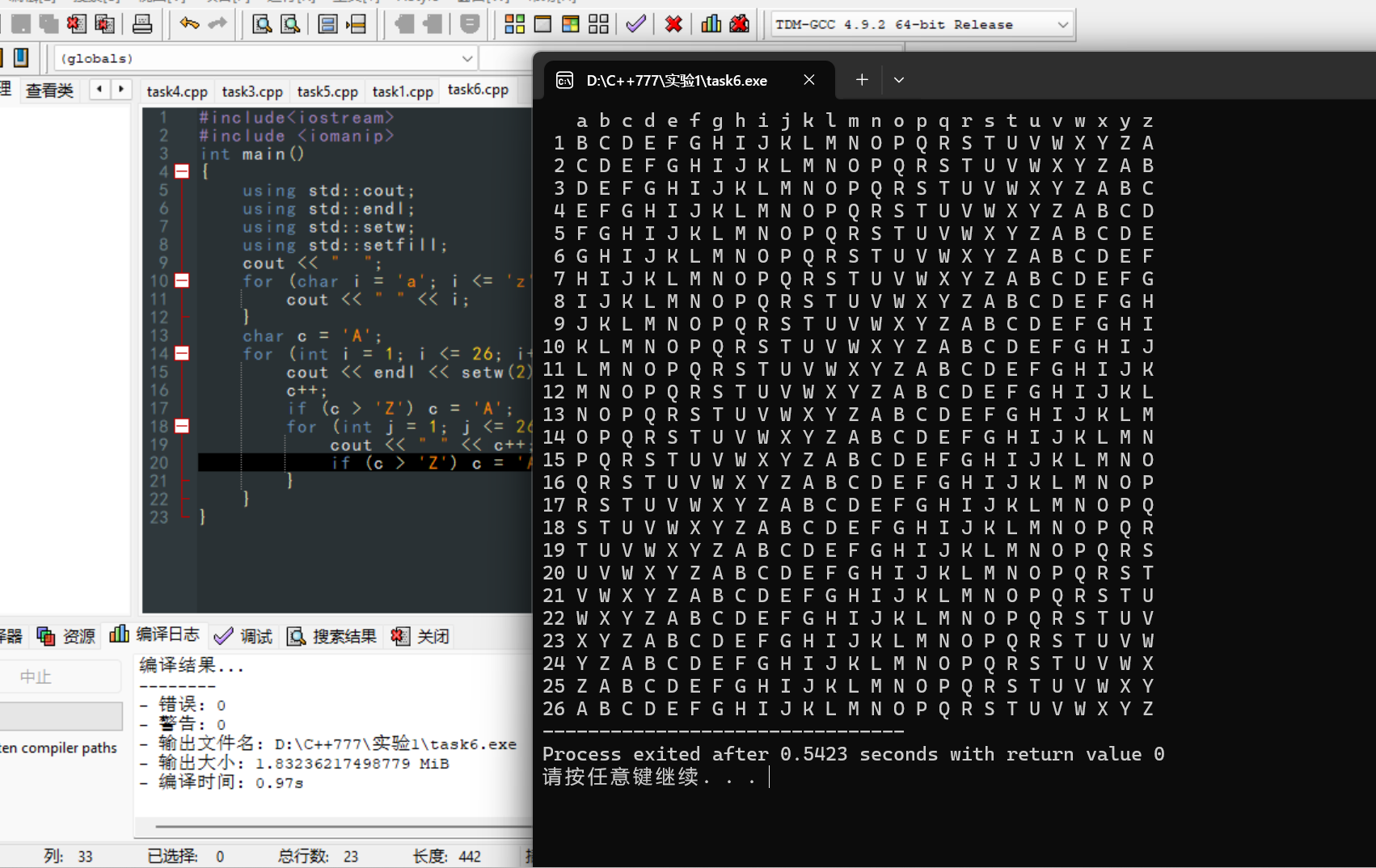
实验任务7
代码7
//尽量保证每种算术都有,且除法的生成效果更好 #include<iostream> #include <cstdlib> #include <ctime> inline char Symbol(int x) { switch(x) { case 0: return '+'; case 1: return '-'; case 2: return '*'; case 3: return '/'; } } inline int Rand10() { return rand() % 10 + 1; } int getSymbol() // 确保每种符号都训练到,且每种符号算式保底数量为2 { static int a[10] = {0, 0, 1, 1, 2, 2, 3, 3}; static bool is_generated = false; static int which_symbol = 0; if (!is_generated) {//和扫雷高效生成雷区的思路差不多 for (int i = 0; i < 10; i++) { if (i > 7) { a[i] = rand() % 4; } int brief = a[i], choice = rand() % 10; a[i] = a[choice]; a[choice] = brief; } is_generated = true; } return a[which_symbol++]; } int main() { using std::cout; using std::cin; using std::endl; srand(time(0)); int right = 0; for (int i = 1; i <= 10; i++) { int digit, a, b, ans, myAns; switch (digit = getSymbol()) { case 0: //加法 a = Rand10(); b = Rand10(); ans = a + b; break; case 1: //减法 a = Rand10(); b = rand() % a + 1; //减数小于等于被减数 ans = a - b; break; case 2: //乘法 a = Rand10(); b = Rand10(); ans = a * b; break; case 3: //除法 /* 我之前写过一个版本,它只能满足题意,但生成效果并不理想,有没有一种更好的生成方式呢? 除法分为两类,第一类为形式 n / 1 = n 或者形式 n / n = 1 如果随机抽取,则抽取到这种的可能性较大,但它的训练意义很鸡肋 第二类在被除数10以内的限制下只有8种,打表都可以 4 / 2 = 2 ;6 / 2 = 3 ;6 / 3 = 2 ;8 / 2 = 4 ;8 / 4 = 2 ;9 / 3 = 3 ;10 / 2 = 5 ;10 / 5 = 2; 这一类更具有训练意义 我们知道生成的除法的数量是2~4 ,因为我们生成时保证了每种运算的训练都至少2个 所以我们希望第一类和第二类至少都要有,但第一类不超过2个,且为2时包含其两种形式 思路就是记忆第一类生成的个数和第其一次生成时采用的形式,以及第一次生成的是谁 1.第一次生成完全随机, 2.如果是第二次生成,则先和第一次生成的结果不在同一类 3.如果第一类且其个数已经为2,则改为生成第二类 4.如果是第二次生成第一类,则必然与其第一次的形式不同 */ static int generate_times = 0, type0times = 0, type1times = 0, first_type, type, first_type0_mode = -1; if (!generate_times) { type = first_type = rand() % 2; } else { if (generate_times == 1) { type = (1 + first_type) % 2; } else if (type0times > 1) { type = 1; } else { type = rand() % 2; } } int type0_mode; if (type == 0) { if (first_type0_mode == -1) { first_type0_mode = rand() % 2; type0_mode = first_type0_mode; } else { type0_mode = (1 + first_type0_mode) % 2; } if (type0_mode == 0) { a = Rand10(), b = 1, ans = a; } else { a = Rand10(), b = a, ans = 1; } } else { static int type1_mode_available[8] = {1, 2, 3, 0, 0, 0, 0, 0}; //初始化就考虑周全,避免重复 static int type1_mode[3]; if (!type1times) { for (int j = 0; j < 3; j++) { int brief = type1_mode_available[j], choice = rand() % 8; type1_mode_available[j] = type1_mode_available[choice]; type1_mode_available[choice] = brief; } for (int j = 0; j < 8; j++) { if (type1_mode_available[j]) { type1_mode[type1_mode_available[j] - 1] = j; } } } switch(type1_mode[type1times++]) { case 0: a = 4, b = 2; break; case 1: a = 6, b = 2; break; case 2: a = 6, b = 3; break; case 3: a = 8, b = 2; break; case 4: a = 8, b = 4; break; case 5: a = 9, b = 3; break; case 6: a = 10, b = 2; break; case 7: a = 10, b = 5; } ans = a / b; } generate_times++; } cout << a << " " << Symbol(digit) << " " << b << " = "; cin >> myAns; if (myAns == ans) { right++; } } cout << "正确率:" << right * 10 << ".00%"; //小心!正确率为0时不能输出成00.00% }
运行截图7-1
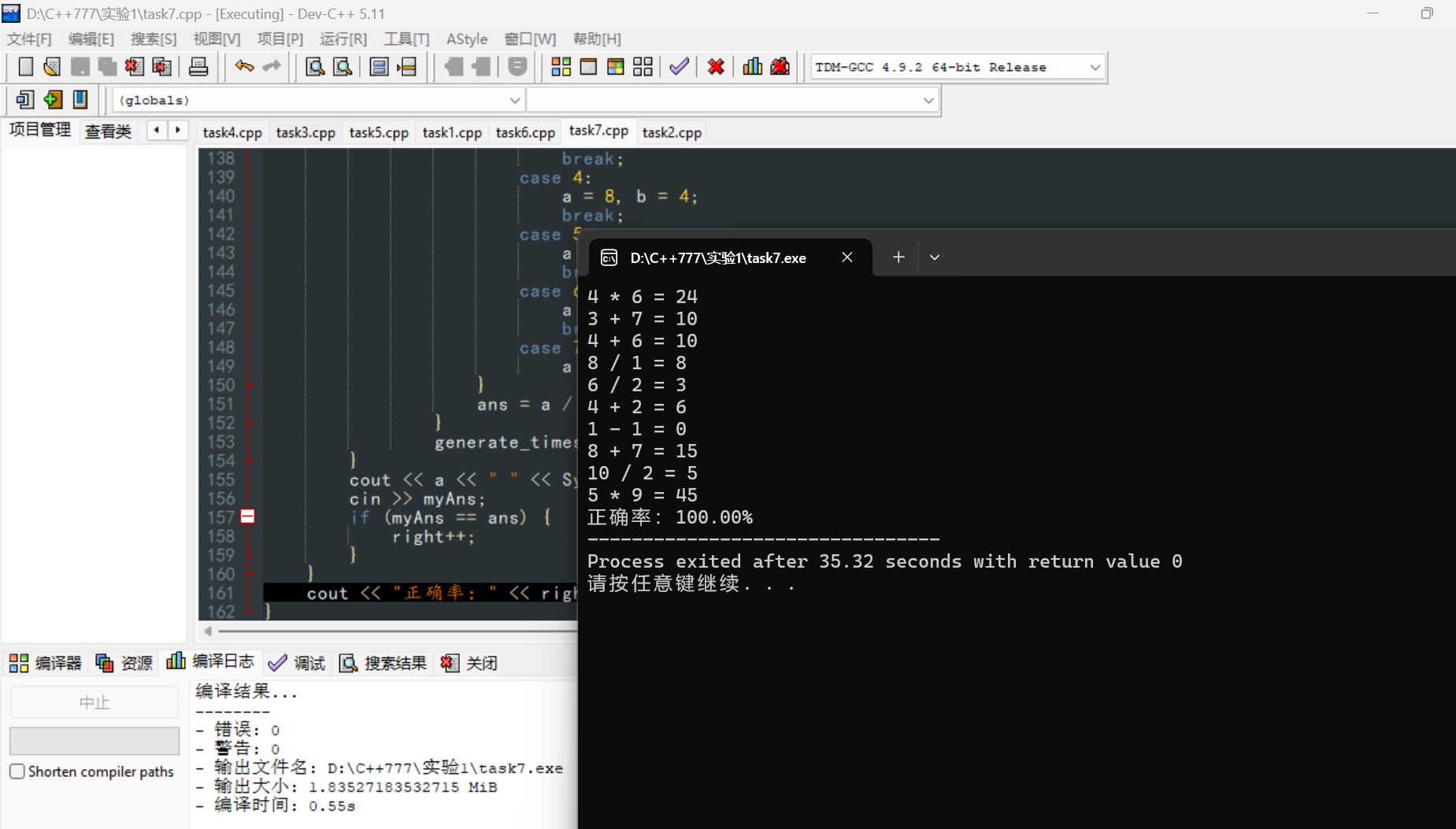
运行截图7-2
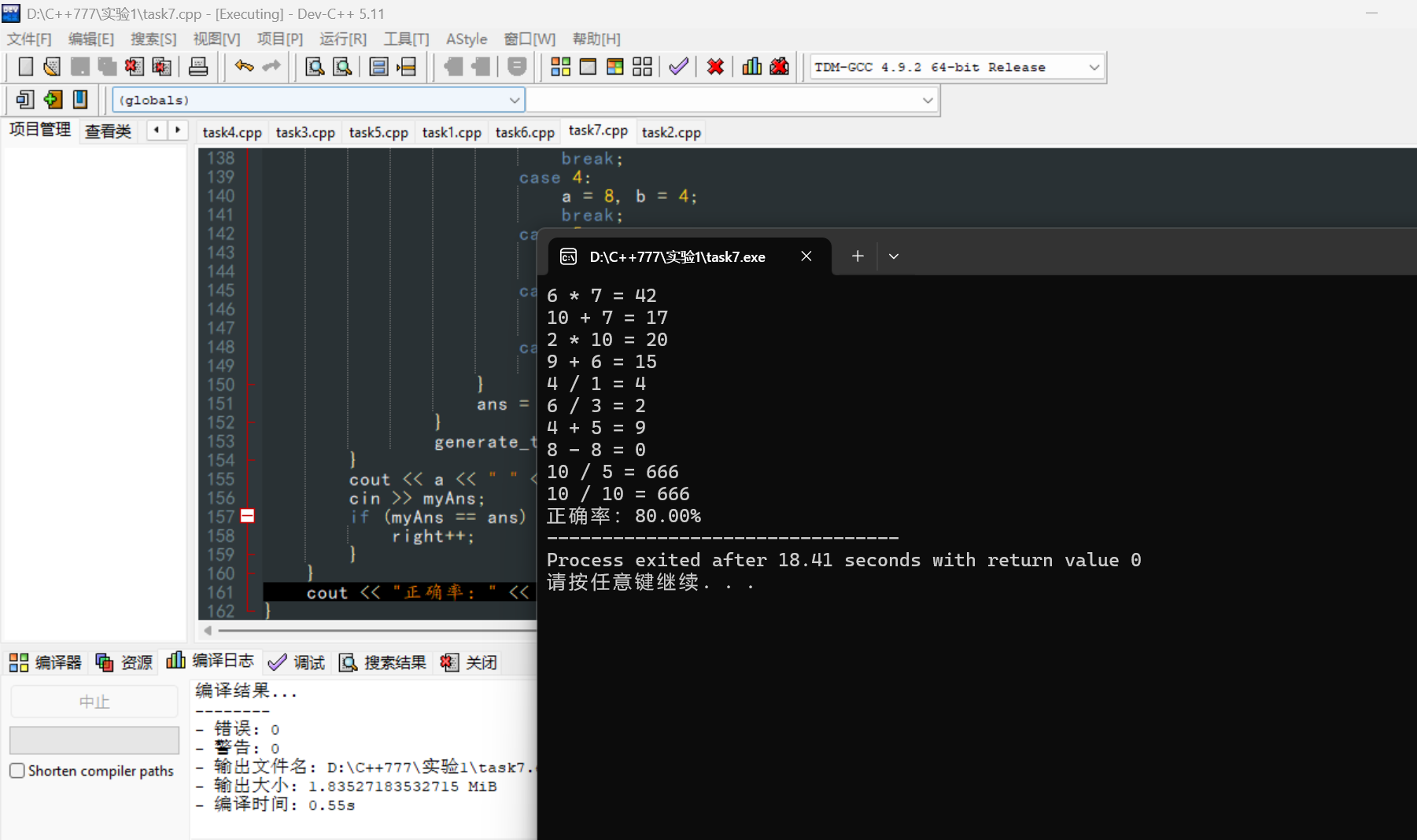
运行截图7-3
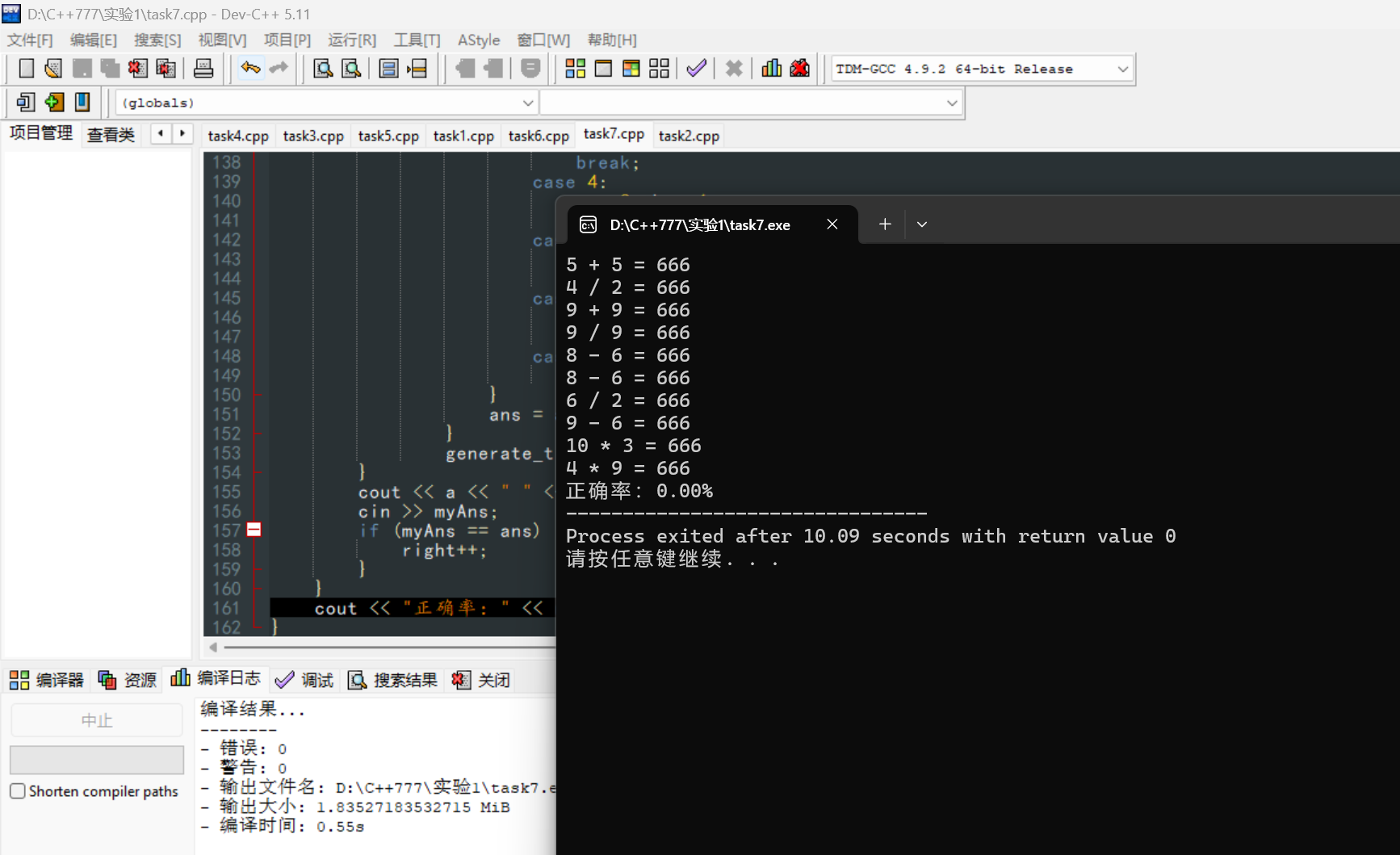
五、实验总结
这次实验最令我思考的是实验7,因为这个任务相对开放,一开始我使用了一种很简便的方式就实现了实验的要求,但是我注意到有一定概率10道题里有概率会有一种运算较少甚至没有,所以在符号生成部分我设计了一个优化的实现,保证10道题里每种运算至少有2道;其次我注意到除法的生成常规的实现方式效果不理想,总是出现n/1=n或n/n=1的形式,而三个数里不含1的形式较少,我就详细分析了其成因,发现是因为被除数的范围实在太小,于是我设计了一个有保底的随机生成策略,使得每次10道题里这几种除法算式能均衡地生成。
前面的实验让我比较有收获的是发现有很多方法可以拿来直接用,不需要自己动手写。
比较遗憾的是由于时间问题,实验7没有写成面向对象的程序设计形式,所以其可移植性不高,所以我让AI帮我改了一下实现方式,但不改变逻辑,经过我的学习和调试,发现这个代码能跑,且我觉得它挺棒的,所以我想把它分享在最后。
#include <iostream> #include <array> #include <vector> #include <random> #include <algorithm> class SymbolSequence { public: SymbolSequence(std::mt19937 &rng) : rng_(rng) { init(); } int next() { if (index_ < seq_.size()) return seq_[index_++]; // 防御:如果意外请求超过10个,循环返回最后一个 return seq_.back(); } static char toChar(int symbol) { switch (symbol) { case 0: return '+'; case 1: return '-'; case 2: return '*'; case 3: return '/'; default: return '?'; } } private: void init() { // 与原逻辑一致:先设定前8个保证每种运算至少2次,后两个随机, // 然后按原算法逐步随机交换,得到长度为10的排列/组合 seq_ = {0, 0, 1, 1, 2, 2, 3, 3, 0, 0}; std::uniform_int_distribution<int> pick10(0, 9); for (size_t i = 0; i < seq_.size(); ++i) { if (i > 7) seq_[i] = pick4(); int choice = pick10(rng_); std::swap(seq_[i], seq_[choice]); } } int pick4() { return std::uniform_int_distribution<int>(0, 3)(rng_); } std::array<int, 10> seq_; std::size_t index_ = 0; std::mt19937 &rng_; }; class DivisionGenerator { public: DivisionGenerator(std::mt19937 &rng) : rng_(rng) {} // 生成除法题(按原逻辑保证第一类/第二类分布与顺序) void generate(int &a, int &b, int &ans) { int type; // 0 = 第一类 (n/1 或 n/n),1 = 第二类(打表的8种) if (generate_times_ == 0) { type = first_type_ = uniform2(); } else if (generate_times_ == 1) { type = (1 + first_type_) % 2; } else if (type0times_ > 1) { type = 1; } else { type = uniform2(); } if (type == 0) { int type0_mode; if (first_type0_mode_ == -1) { first_type0_mode_ = uniform2(); type0_mode = first_type0_mode_; } else { type0_mode = (1 + first_type0_mode_) % 2; } if (type0_mode == 0) { a = rand10(); b = 1; ans = a; } else { a = rand10(); b = a; ans = 1; } ++type0times_; } else { if (type1times_ == 0) { prepare_type1_modes(); } int mode = type1_modes_[type1times_++]; switch (mode) { case 0: a = 4; b = 2; break; case 1: a = 6; b = 2; break; case 2: a = 6; b = 3; break; case 3: a = 8; b = 2; break; case 4: a = 8; b = 4; break; case 5: a = 9; b = 3; break; case 6: a = 10; b = 2; break; case 7: a = 10; b = 5; break; default: a = 10; b = 2; break; } ans = a / b; } ++generate_times_; } private: int uniform2() { return std::uniform_int_distribution<int>(0, 1)(rng_); } int rand10() { return std::uniform_int_distribution<int>(1, 10)(rng_); } void prepare_type1_modes() { // 从0..7中随机选择3个不同的序号(与原实现等价) std::vector<int> pool(8); for (int i = 0; i < 8; ++i) pool[i] = i; std::shuffle(pool.begin(), pool.end(), rng_); type1_modes_.assign(pool.begin(), pool.begin() + 3); } std::mt19937 &rng_; int generate_times_ = 0; int type0times_ = 0; int type1times_ = 0; int first_type_ = 0; int first_type0_mode_ = -1; std::vector<int> type1_modes_; }; class ProblemGenerator { public: ProblemGenerator(std::mt19937 &rng) : rng_(rng), seq_(rng), divgen_(rng) {} // 生成一题(返回运算类型、操作数与答案) void next(int &symbol, int &a, int &b, int &ans) { symbol = seq_.next(); if (symbol == 0) { // 加 a = rand10(); b = rand10(); ans = a + b; } else if (symbol == 1) { // 减,保证被减数 >= 减数 a = rand10(); b = std::uniform_int_distribution<int>(1, a)(rng_); ans = a - b; } else if (symbol == 2) { // 乘 a = rand10(); b = rand10(); ans = a * b; } else { // 除 (调用复杂逻辑) divgen_.generate(a, b, ans); } } static char symbolChar(int s) { return SymbolSequence::toChar(s); } private: int rand10() { return std::uniform_int_distribution<int>(1, 10)(rng_); } std::mt19937 &rng_; SymbolSequence seq_; DivisionGenerator divgen_; }; int main() { std::mt19937 rng((std::random_device())()); ProblemGenerator gen(rng); int right = 0; for (int i = 0; i < 10; ++i) { int symbol, a, b, ans; gen.next(symbol, a, b, ans); std::cout << a << " " << ProblemGenerator::symbolChar(symbol) << " " << b << " = "; int myAns; if (!(std::cin >> myAns)) { // 非法输入或 EOF 时安全退出 std::cerr << "\n输入错误,程序退出。\n"; return 1; } if (myAns == ans) ++right; } // 与原输出保持一致(每题占10%,保留 .00) std::cout << "正确率:" << (right * 10) << ".00%"; return 0; }



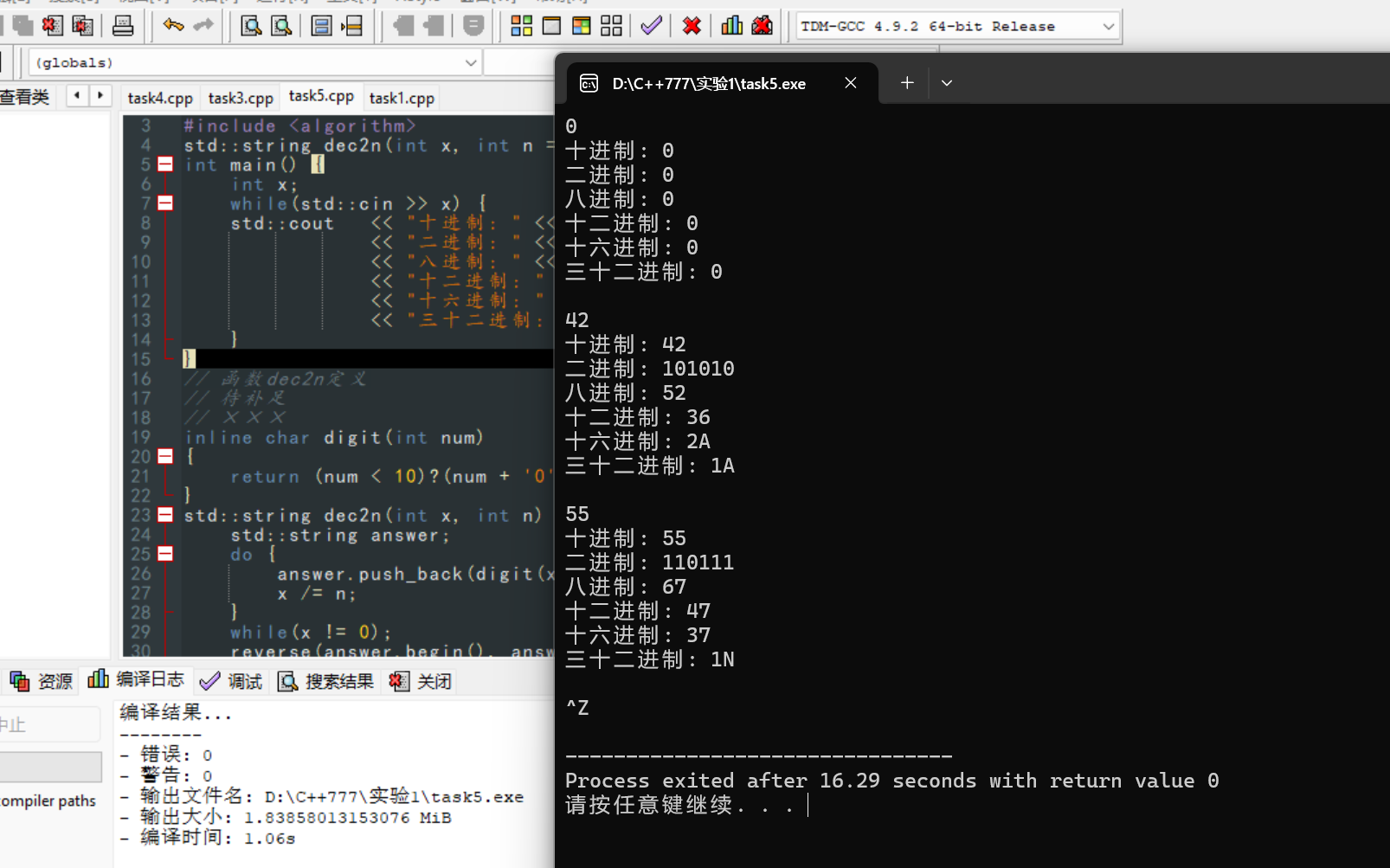

 浙公网安备 33010602011771号
浙公网安备 33010602011771号